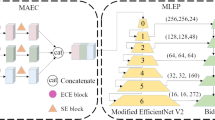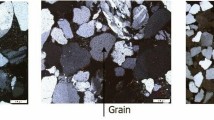Abstract
We propose the neural network-based method for segmentation of minerals in images of geological polished sections. We use a specific image set where the images are taken in plane-polarized (PPL) and cross-polarized (XPL) light, with different rotation angles relative to the optical axis of the camera. The data set, formed in that way, allows to obtain additional information that improves the quality of the anisotropic mineral segmentation, as that type of minerals changes its color (“blinks“) depending on the rotation angle when imaging under the XPL light. The peculiarity of our method is the registration of the XPL images with the PPL images of the same polished section which is further fed to the neural network. Additionally, a data balancing algorithm was used to compensate for the non-uniform occurrence of different minerals in the image set. Five segmentation models have been trained both with using additional images and without using them. The results have demonstrated that using XPL images, registered in advance with the corresponding PPL image, improves the quality of segmentation by 3–12 percent for anisotropic minerals and by 1–8 percent for isotropic minerals.








Similar content being viewed by others
References
Marschallinger, R.: Automatic mineral classification in the macroscopic scale. Comput. Geosci. 23(1), 119–126 (1997). https://www.sciencedirect.com/science/article/pii/S009830049600074X
Khvostikov, A.V., Korshunov, D.M., Krylov, A.S., Boguslavskiy, M.A.: Automatic identification of minerals in images of polished sections. The International Archives of Photogrammetry, Remote Sensing and Spatial Information Sciences, vol. 44, pp. 113–118 (2021)
López-Benito, A., Catalina, J.C., Alarcón, D.: Automated ore microscopy based on multispectral measurements of specular reflectance. I–A comparative study of some supervised classification techniques. Minerals Engineering, vol. 146, p. 106136 (2020)
Berrezueta, E., Ordóñez-Casado, B., Bonilla, W.: Ore Petrography Using Optical Image Analysis: Application to Zaruma-Portovelo Deposit (Ecuador). Geosciences 6(2), (2016). https://www.mdpi.com/2076-3263/6/2/30
Köse, C., İbrahim, A., İkibaş, C.: Statistical methods for segmentation and quantification of minerals in ore microscopy. Miner. Eng. 30, 19–32 (2012)
Barraud, J.: The use of watershed segmentation and GIS software for textural analysis of thin sections. J. Volcanol. Geotherm. Res. 154(1‑2), 17–33 (2006)
Sheppard, A.P., Robert, S.M., Averdunk, H.: Techniques for image enhancement and segmentation of tomographic images of porous materials. Phys. A: Stat. Mech. Its Appl. 339(1‑2), 145–151 (2004)
Berrezueta, E., Ordóñez-Casado, B., Bonilla, W.: Ore petrography using optical image analysis: application to Zaruma-Portovelo deposit (Ecuador). Geosciences 6(2), 30 (2016)
Indychko, O.I., Khvostikov, A.V., Korshunov, D.M.: Color Adaptation in Images of Polished Sections of Geological Specimens [in Russian]. Comput. Math. Model. 33, 487–500 (2022). https://doi.org/10.1007/s10598-023-09588-z
Ronneberger, O., Fischer, P., Brox, T.: U‑Net: Convolutional networks for biomedical image segmentation. International Conference on Medical Image Computing and Computer-Assisted Intervention. Springer, pp. 234–241 (2015)
Szegedy, C., Ioffe, S., Vanhoucke, V., Alemi, A.A.: Inception-v4, Inception-ResNet and the Impact of Residual Connections on Learning. Thirty-first AAAI Conference on Artificial Intelligence., pp. 4278–4284 (2017)
Tang, H., Wang, H., Wang, L., Cao, C., Nie, Y., Liu, S.: An Improved Mineral Image Recognition Method Based on Deep Learning. JOM 75(7), 2590–2602 (2023). https://doi.org/10.1007/s11837-023-05792-9
Lowe, D.G.: Object recognition from local scale-invariant features. Proceedings of the Seventh IEEE International Conference on Computer Vision, vol. 2. IEEE, pp. 1150–1157 (1999)
Fischler, M.A., Bolles, R.C.: Random sample consensus: a paradigm for model fitting with applications to image analysis and automated cartography. Commun. ACM 24(6), 381–395 (1981)
Kochkarev, A., Khvostikov, A., Korshunov, D.: Data balancing method for training segmentation neural networks. CEUR Workshop Proceedings, vol. 2744, pp. 1–10 (2020)
Funding
The research was funded by the Russian Science Foundation grant No. 22-21-00125.
Author information
Authors and Affiliations
Corresponding author
Additional information
Translated from Prikladnaya Matematika i Informatika, No. 73, 2023, pp. 23–37
This article is a translation of the original article published in Russian in the journal Prikladnaya Matematika i Informatika. The translation was done with the help of an artificial intelligence machine translation tool, and subsequently reviewed and revised by an expert with knowledge of the field. Springer Nature works continuously to further the development of tools for the production of journals, books and on the related technologies to support the authors.
Publisher’s Note
Springer Nature remains neutral with regard to jurisdictional claims in published maps and institutional affiliations.
Rights and permissions
Springer Nature or its licensor (e.g. a society or other partner) holds exclusive rights to this article under a publishing agreement with the author(s) or other rightsholder(s); author self-archiving of the accepted manuscript version of this article is solely governed by the terms of such publishing agreement and applicable law.
About this article
Cite this article
Razzhivina, D., Korshunov, D., Boguslavsky, M. et al. Registration and segmentation of PPL and XPL images of geological polished sections containing anisotropic minerals. Comput Math Model (2024). https://doi.org/10.1007/s10598-024-09592-x
Accepted:
Published:
DOI: https://doi.org/10.1007/s10598-024-09592-x




